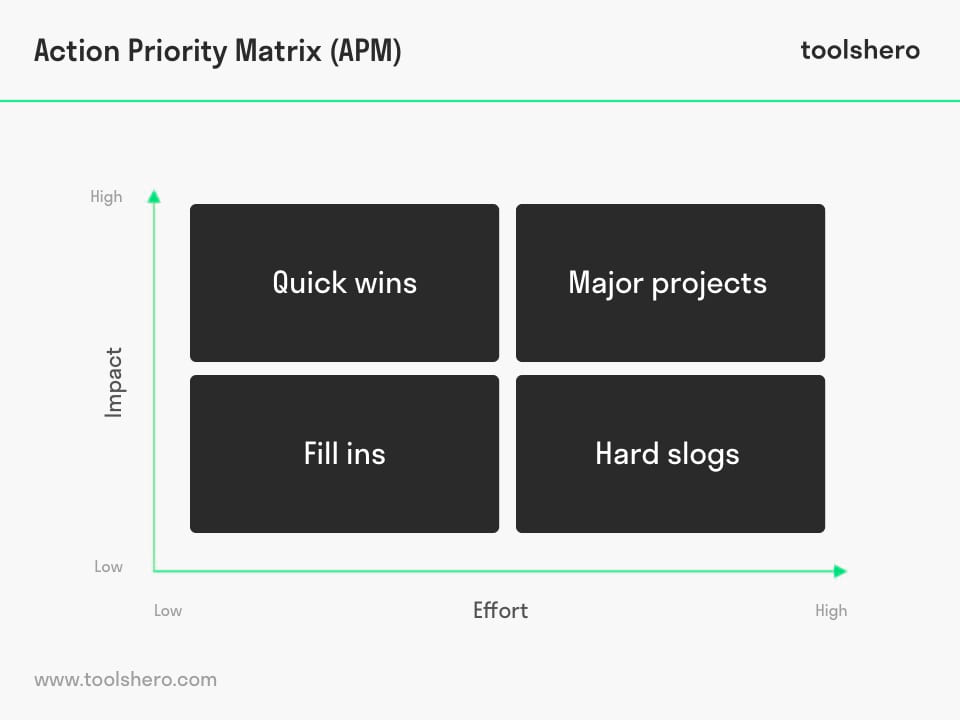Action Priority Matrix explained plus template

Action Priority Matrix (APM): this article explains the Action Priority Matrix (APM) in a practical way. After reading you will understand the basics of this powerful time management tool. This article also contains a downloadable and editable Action Priority Matrix template. Enjoy reading!
What is an Action Priority Matrix (APM)? The theory explained
People in organizations have busy diaries overflowing with appointments and various activities. The Action Priority Matrix helps people find their way to balance and helps prioritize options.
An Action Priority Matrix (APM) makes it easier to make decisions and sets out clearly which activities must be finished on time and which activities can be omitted or performed at a later time.
This Matrix is a simple diagramming technique that helps you choose which activities to prioritize in order to make the most efficient use of your time. In an APM the Efforts of the activity (x-axis) are plotted perpendicularly on the Impact/ detailing (y-axis).

Figure 1 – The Action Priority Matrix
This creates four possibilities:
1. Quick wins
These activities are characterized by a high Impact in combination with a low Effort. They are the most attractive activities / projects that give good returns for relatively little effort. These activities can be completed routinely without affecting quality and they support the business continuity process. It is advisable to focus on these quick wins as much as you can.
2. Major projects in the Action Priority Matrix
These activities have both a high Impact and a High Effort. They give good returns for a company but they take a long time to complete. Make sure that major projects do not crowd out the Quick Wins. It is important to pay much attention to these Major Projects, so that the execution of the activities can be mastered well. Working quickly and efficiently can be helpful in this.
3. Fill Ins
The so-called ‘fill ins’ have a low Impact and a low Effort. These are low-priority activities that can be dealt with at a later time. Often ‘fill ins’ stagnate activities with a higher priority. Eventually, these will have to be carried out. It is therefore advisable to make a list with ‘fill ins’ and you should only perform these tasks when you have got the time to do so.
4. Hard Slogs
The Hard Slogs or “thankless tasks” have a low Impact but require a high Effort. When a computer programme is not functioning properly and an employee spends all day trying to make this work, this must be seen as a waste of time and energy. It is therefore advisable to avoid Hard Slogs and outsource them to experts. If you do not do this, thankless and energy consuming tasks will yield low returns and there will be too little time for more important business.
Action Priority Matrix: Efficient use
In order to use an APM efficiently, it is recommended to use scores for impact from 0 to 10 in which ‘0’ represents no Impact and no Effort and ‘10’ represents maximum Impact and Maximum Effort.
It is possible of course to use another scale. Using this score, the activities of the Matrix can be plotted more carefully resulting in an easier selection with respect to priority.
Effect Long term of using the Action Priority Matrix
By using an APM, activities are sequenced in the right order based on priority and therefore time will be used more efficiently. This will have a positive effect in the long term.
Employees will therefore become more and more aware of time-consuming projects and will have a better understanding of activities that give good returns. This is why APM is an effective management tool: it improves the decision-making process and it minimizes stress.
Summary
The Action Priority Matrix is a popular tool used to prioritize tasks based on their level of impact and effort required. This matrix is used to categorize tasks into four quadrants: quick wins (low effort, high impact), major projects (high effort, high impact), fill-ins (low effort, low impact), and thankless tasks (high effort, low impact). By using this framework, individuals and teams can focus on quick wins and major projects, which have the potential to yield significant results, while minimizing the amount of effort spent on tasks with low impact. This approach can help individuals and teams avoid burnout and ensure that they are using their time and resources effectively.
Action Priority Matrix template
Get a head start with prioritizing options and make the most efficient use of your time with this ready to use Action Priority Matrix template.
Download the Action Priority Matrix template
This template is exclusively for our paying Toolshero members. Click here to see if a membership is something for you!It’s Your Turn
What do you think? Is the APM still applicable in today’s modern task management? Do you recognize the practical explanation or do you have more suggestions? What are your success factors for good priority task management?
Share your experience and knowledge in the comments box below.
More information
- Sandler, L. (2007). Becoming an Extraordinary Manager: The 5 Essentials for Success. AMACOM.
- Covey, S. R., Merrill, A. R., & Merrill, R. R. (1995). First things first. Simon and Schuster.
How to cite this article:
Mulder, P. (2012). Action Priority Matrix. Retrieved [insert date] from Toolshero: https://www.toolshero.com/personal-development/action-priority-matrix-apm/
Originally published on: 09/21/2012 | Last update: 05/29/2023
Add a link to this page on your website:
<a href=”https://www.toolshero.com/personal-development/action-priority-matrix-apm/”>Toolshero: Action Priority Matrix</a>













2 responses to “Action Priority Matrix explained plus template”
Very informative and easily understandable.
Thank you for your feedback Sathish. I am glad that you found the article helpful.